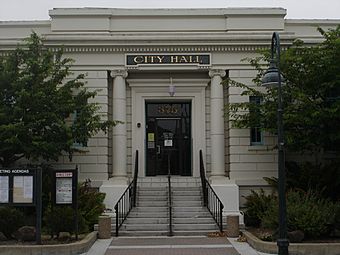Hollister Carnegie Library facts for kids
Quick facts for kids |
|
|
Hollister Carnegie Library
|
|

The Hollister Carnegie Library building now serves as the city hall.
|
|
| Location | 375 Fifth St., Hollister, California |
|---|---|
| Area | less than one acre |
| Built | 1912 |
| Architectural style | Classical Revival |
| MPS | California Carnegie Libraries MPS |
| NRHP reference No. | 92000269 |
| Added to NRHP | March 26, 1992 |
The Hollister Carnegie Library is a historic building in Hollister, California. It was first known as the Hollister Free Public Library. Today, it serves as the Hollister City Hall.
This important building is located at 375 Fifth Street. It opened in 1912 as a Carnegie library. Years later, it was changed to become the city's main government building. The building is part of a special historic area downtown. It was added to the National Register of Historic Places on March 26, 1992.
Contents
Building a Community Library
Hollister had a public library that started way back in 1884. Over time, it changed names and locations. It was run by different groups, including the Woman's Christian Temperance Union. In the early 1900s, the library moved to a house on Fifth Street. However, it soon became too small for the growing community.
In 1910, something exciting happened. The city received a grant of $10,000 from the Andrew Carnegie Library Foundation. Andrew Carnegie was a very rich businessman who helped build many libraries across the United States. Construction of the new Carnegie library began in 1911.
Who Designed and Built It?
The library was designed by William Binder from San Jose. The main builder was E. J. Sparling, who was from Hollister. The total cost for the project was about $12,517. This included money for the land, the building itself, and the furniture inside.
From Library to City Hall
The Carnegie Library served the community for many years. But in 1960, the Hollister library joined with the San Benito County library. They moved into a brand new building nearby. The beautiful Carnegie building then found a new purpose. It was repurposed to become the city hall, where local government business takes place.
Architecture of the Carnegie Library
The Hollister Carnegie Library is a one-story building with a basement. It was designed in a style called Classical Revival. This style often uses elements from ancient Greek and Roman buildings. The building sits a little bit higher than the street. It has a retaining wall, a lawn, a garden, and a walkway leading to it.
Key Features of the Design
The building has an asphalt roof and decorative molded panels. You can also see Ionic columns at the entrance. These are tall, round columns with a special scroll-like design at the top. The building also has both outside and inside stairways. It features casement windows, which open outwards like a door.
The structure was built with reinforced concrete for its foundation and walls. This was a smart choice because Hollister is located near the Calaveras Fault. Building with strong materials like concrete helps a building stand up better to earthquakes. In 1986, a small expansion was added to the back of the building.



